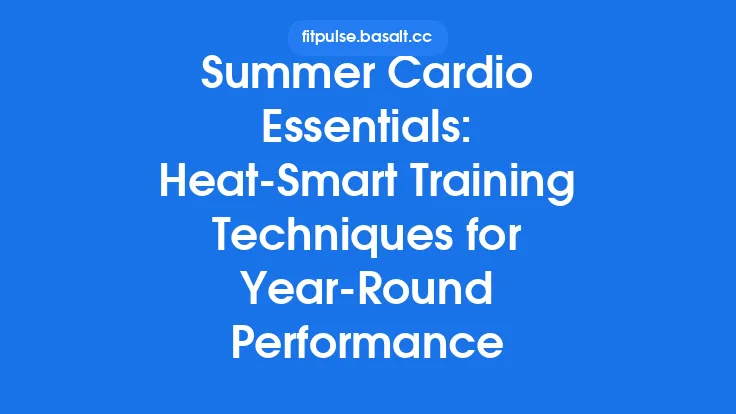Swimming performance hinges on more than just raw strength or flawless technique; it is equally a matter of how efficiently a swimmer can manage energy over the course of a race. Understanding swim pace and mastering interval training are the twin pillars that allow athletes to translate physiological potential into faster times. This article delves into the concepts, science, and practical methods behind pacing and interval work, offering a roadmap for swimmers of all levels who want to extract measurable performance gains.
What Is Swim Pace and Why It Matters
Swim pace is the speed at which a swimmer covers a given distance, typically expressed as time per 100 meters (or yards). While the raw time of a race is the ultimate outcome, the underlying pace profile determines how that time is achieved. A well‑controlled pace:
- Optimizes Energy Distribution – Prevents early lactate accumulation that can cause a dramatic slowdown in the final laps.
- Aligns With Race Strategy – Allows swimmers to execute negative splits (swimming the second half faster) or even‑splits (maintaining a consistent speed) as required by the event.
- Facilitates Predictable Training Adaptations – Consistent pacing in practice mirrors race conditions, making physiological adaptations more specific.
In essence, pace is the bridge between the swimmer’s aerobic and anaerobic systems, dictating how much of each energy pathway is tapped during a set distance.
Physiological Foundations of Pace and Interval Training
| System | Primary Energy Source | Typical Pace Range | Training Focus |
|---|---|---|---|
| Aerobic | Oxidative phosphorylation (fat & carbohydrate) | Low‑to‑moderate (e.g., 2:00–2:30 / 100 m for elite distance swimmers) | Long, steady intervals; builds endurance and capillary density |
| Anaerobic‑Lactate | Glycolysis (carbohydrate) | Moderate‑to‑high (e.g., 1:30–1:45 / 100 m) | Short, high‑intensity intervals; raises lactate threshold |
| Anaerobic‑Alactic (ATP‑CP) | Phosphocreatine system | Sprint (e.g., <1:10 / 100 m) | Very short, maximal effort repeats; improves power and start/turn explosiveness |
Interval training manipulates the balance between these systems by varying work‑to‑rest ratios, set lengths, and target paces. By systematically stressing a particular energy pathway, swimmers can shift the lactate threshold upward, increase VO₂max, and improve neuromuscular efficiency—all of which translate into faster race paces.
Measuring and Monitoring Pace
Accurate pace data is the cornerstone of effective interval work. Modern swimmers have several reliable options:
- Stopwatch with Lap Splits – The simplest method; requires manual recording of each 25 m/50 m split.
- Wearable Swim Watches – Devices such as the Garmin Swim, Apple Watch, or Polar Vantage V2 use accelerometers and gyroscopes to auto‑detect laps and calculate pace.
- Underwater Video Analysis – High‑speed cameras placed at the pool side can provide frame‑by‑frame split times, useful for fine‑tuning pacing in elite training.
- Pool Timing Systems – Competitive pools equipped with touchpads deliver precise split data, ideal for benchmarking.
Regardless of the tool, consistency in measurement (same pool length, same start protocol) is essential for tracking true progress.
Designing Effective Interval Sets
An interval set is defined by three variables: distance (or time) of the work interval, target pace, and rest interval. The interaction of these variables determines the training stimulus.
- Determine the Goal – Is the set aimed at aerobic endurance, lactate tolerance, or sprint power?
- Select the Work Distance – Typical ranges:
- Aerobic: 200–400 m repeats
- Lactate: 100–200 m repeats
- Alactic: 25–50 m repeats
- Assign a Target Pace – Use a percentage of race pace or a physiological marker (e.g., 85 % of VO₂max pace).
- Set the Rest Interval – Rest can be:
- Passive (standing or floating) – emphasizes recovery.
- Active (easy swimming) – maintains blood flow and simulates race‑like fatigue.
- Time‑Based (e.g., 20 s) or Distance‑Based (e.g., 100 m easy) – choose based on the desired intensity.
Example of a lactate‑focused set:
8 × 150 m at 90 % of 400 m race pace, 20 s passive rest.
This structure pushes the swimmer into the upper anaerobic‑lactate zone while providing enough recovery to maintain quality across repeats.
Pace Variations for Different Race Distances
| Event | Recommended Pace Strategy | Typical Interval Structure |
|---|---|---|
| 50 m Sprint | All‑out, maximal effort; focus on start and turn speed | 6 × 25 m at race pace, full recovery (2–3 min) |
| 100 m | Negative split or even‑split; aim to finish strong | 4 × 75 m at 95 % race pace, 30 s rest |
| 200 m | Slightly faster first 100 m, maintain in second 100 m | 5 × 100 m at 90 % race pace, 20 s rest |
| 400 m | Even‑split or mild positive split; focus on aerobic base | 4 × 200 m at 85 % race pace, 30 s rest |
| 800 m & 1500 m | Consistent aerobic pace; occasional “pace‑pull” sets | 3 × 400 m at 80 % race pace, 45 s rest |
Understanding the pacing nuances for each distance helps swimmers select interval sets that mimic race demands, ensuring the body adapts to the exact speed profile it will encounter on competition day.
Integrating Pace Work into a Weekly Training Plan
A balanced weekly schedule typically blends three types of sessions:
| Day | Session Focus | Example Set |
|---|---|---|
| Monday | Recovery + Technique (low intensity) | 4 × 200 m easy, 30 s rest |
| Tuesday | Aerobic Endurance | 5 × 400 m at 80 % race pace, 45 s rest |
| Wednesday | Speed & Power | 8 × 25 m sprint, full recovery |
| Thursday | Lactate Threshold | 6 × 150 m at 90 % race pace, 20 s rest |
| Friday | Mixed Pace (race simulation) | 3 × 200 m at 85 % race pace, 30 s rest + 2 × 100 m at race pace |
| Saturday | Long Swim (aerobic base) | 3000 m continuous at comfortable pace |
| Sunday | Rest or active recovery (light swim, mobility) | 1500 m easy + stretching |
The exact distribution can be adjusted based on the swimmer’s competition calendar, training phase, and individual recovery capacity. The key is to ensure that each week contains at least one high‑intensity interval session, one moderate‑intensity lactate set, and sufficient aerobic volume to maintain endurance.
Progression and Overload Strategies
To continue improving, swimmers must apply the principle of progressive overload to pace work. Common methods include:
- Increasing Volume – Add an extra repeat or extend the distance of each interval while keeping the target pace constant.
- Increasing Intensity – Reduce the target pace by 2–5 % (i.e., swim faster) while maintaining the same number of repeats.
- Manipulating Rest – Shorten passive rest intervals or replace passive rest with active recovery to raise the overall training stress.
- Introducing Pace Variability – Incorporate “pace ladder” sets (e.g., 50 m @ 95 % race pace, 100 m @ 90 %, 150 m @ 85 %) to challenge the swimmer’s ability to adjust speed on the fly.
- Periodized Peaks – Align a 2–3 week block of increasingly demanding interval work with the competition taper, then reduce volume sharply to allow supercompensation.
A simple rule of thumb: no more than a 10 % increase in total interval volume or intensity per week to minimize the risk of overtraining.
Common Pitfalls and How to Avoid Them
| Pitfall | Why It Happens | Corrective Action |
|---|---|---|
| Starting Too Fast | Misjudging effort, excitement at the pool deck | Use a “count‑down” cue: begin at 95 % of target pace for the first 25 m, then settle into the planned speed. |
| Inconsistent Rest Timing | Manual timing errors, distractions | Use a metronome or a pool timer that signals rest intervals automatically. |
| Neglecting Recovery Quality | Assuming “hard work” alone drives gains | Incorporate active recovery drills (e.g., easy breaststroke) to flush lactate and maintain circulation. |
| Over‑reliance on One Pace Zone | Training monotony, limited physiological stimulus | Rotate weekly focus: aerobic week, lactate week, sprint week. |
| Ignoring Split Variability | Focusing only on overall set time | Review each 25 m/50 m split; aim for minimal drift from target pace across the set. |
By systematically addressing these issues, swimmers can preserve the integrity of their interval sessions and maximize the training return.
Tools and Technology for Pace Training
- Smart Pool Systems – Platforms like Swim.com or MySwimPro sync with wearable devices, offering real‑time pace alerts and post‑session analytics.
- Pace‑Targeting Apps – Apps that generate interval timers with customizable work/rest cues (e.g., “Interval Timer – HIIT Training” for iOS/Android).
- Heart‑Rate Monitors – While heart rate is less precise in water, chest straps (e.g., Polar H10) can still provide a useful proxy for effort, especially during longer aerobic sets.
- Power Meters for Swimmers – Emerging devices (e.g., SwimPower) measure propulsive force, allowing athletes to correlate power output with pace.
Integrating these tools helps swimmers maintain objective feedback, refine pacing decisions, and track long‑term trends.
Sample Interval Workouts for Various Levels
Beginner (Focus: Establishing Pace Awareness)
- 4 × 100 m at a comfortable, steady pace (≈ 1:30 / 100 m for most recreational swimmers)
Rest: 30 s passive
- 6 × 50 m at a slightly faster pace (≈ 10 % quicker than the 100 m set)
Rest: 20 s passive
Goal: Learn to differentiate between “easy” and “moderately hard” effort while maintaining consistent splits.
Intermediate (Focus: Lactate Threshold Development)
- 5 × 150 m at 90 % of 400 m race pace
Rest: 20 s passive
- 8 × 25 m sprint with 45 s active recovery (easy front‑crawl)
Goal: Push the anaerobic‑lactate system, improve the ability to hold a faster pace for longer.
Advanced (Focus: Race‑Specific Pace Simulation)
- 3 × 200 m at 85 % of 800 m race pace, 30 s rest
- 4 × 100 m at 95 % of 200 m race pace, 20 s rest
- 6 × 50 m at 100 % of 100 m race pace, full recovery (2 min)
Goal: Replicate the pacing demands of middle‑distance events, sharpen the ability to transition between intensity zones within a single session.
Evaluating Progress and Adjusting the Plan
- Track Split Consistency – Over a 4‑week block, the coefficient of variation (CV) of 100 m splits should decrease, indicating improved pacing control.
- Monitor Time‑Trial Performance – Conduct a 400 m time trial every 6–8 weeks; a 1–2 % improvement suggests successful overload.
- Assess Perceived Exertion (RPE) – Use the Borg scale after each interval set. If RPE remains unchanged despite faster paces, the swimmer is adapting positively.
- Review Recovery Metrics – Heart‑rate recovery (HRR) measured 1 minute post‑set should improve (greater drop in bpm) as aerobic capacity rises.
- Adjust Variables – If progress stalls, consider:
- Reducing rest intervals by 5 seconds,
- Adding one extra repeat,
- Slightly lowering target pace (making it faster).
Regular data review ensures the training remains aligned with performance goals and prevents plateaus.
Bottom line: Mastering swim pace and structuring interval training around clear physiological targets empower swimmers to convert training effort into tangible race‑day speed. By measuring accurately, designing purposeful sets, progressing methodically, and leveraging modern tools, athletes can continuously push their performance envelope—turning the abstract concept of “pace” into a concrete, repeatable advantage in the water.





